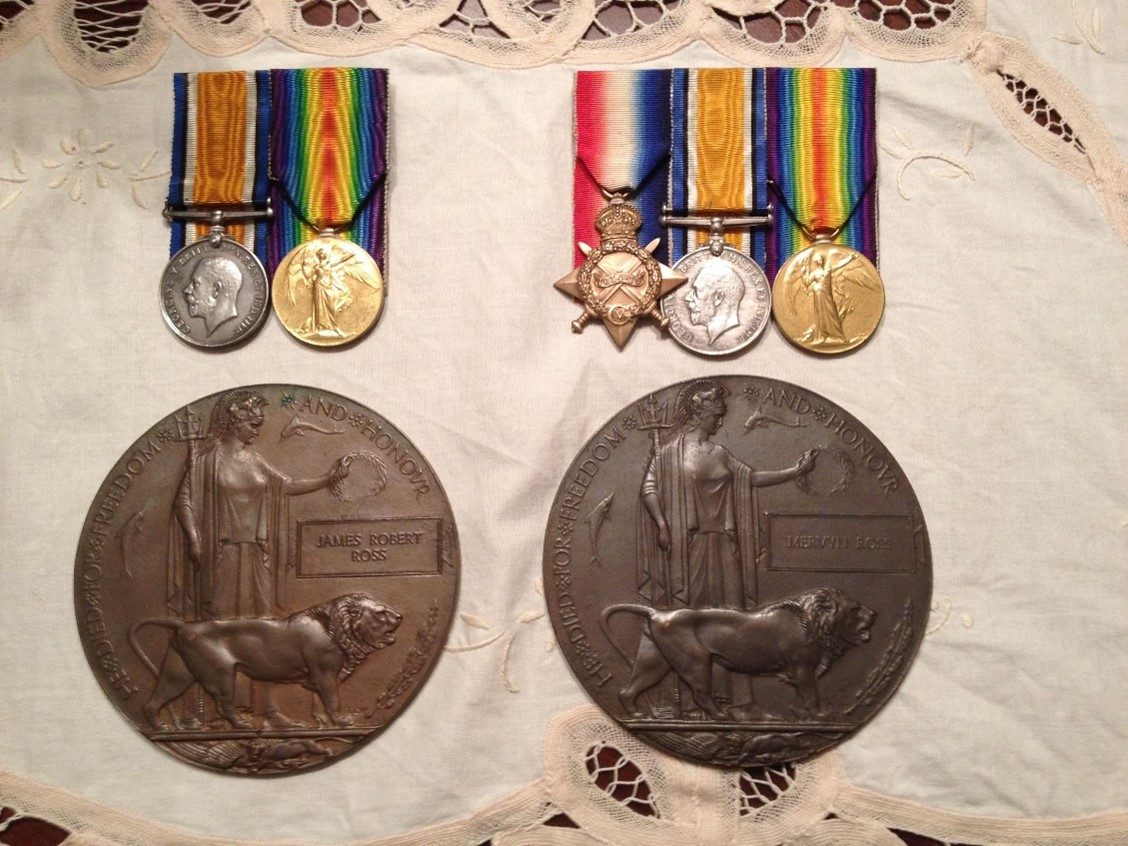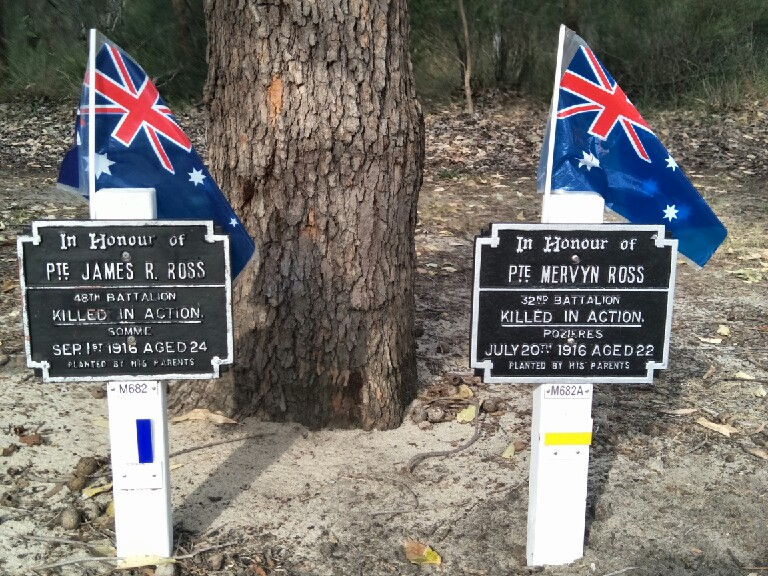Mervyn ROSS
Eyes grey, Hair black, Complexion dark
Ross family
James Waddell Ross married Mary Ann Davis in 1892 in Karridale, a timber town in the south-west of Western Australia. Mary was a local girl from a farming family while James had emigrated from Scotland at age 8 with his parents and two siblings.
After his schooling, James had followed his father to work in the burgeoning timber industry. Shortly after their marriage, James took on work at Lion Mill in what is now known as Mount Helena east of Perth and it was here that James and Mary welcomed their first son James Robert on 10 November 1892. James was probably named in part for his paternal grandfather, Robert Ross, who had been killed in a work accident in August of that same year.
A second son, Mervyn arrived in September 1894 to be followed by Stella in 1896. The family, including James’ widowed mother, moved back to Karridale where James worked at the Jarrahdene Sawmill and the children attended the local Karridale school. A further three children were born between 1897 and 1906 - William (known as Jack), Cecil and Vilma.
At the outbreak of World War 1 in 1914, James Waddell, Mary and their family of four sons and two daughters had moved to Wellington Mills, just up the road from Karridale. James Robert, now 21, was employed as a loco fireman. Mervyn, nearly 20, was a clerk. Both were keen to enlist.
Ross brothers sign up
The first of the two brothers to enlist, Mervyn bumped up his age by a year, and enlisted at Bunbury in July 1915. Following initial training at Blackboy Hill Camp, he was assigned to the 32nd Battalion, a combined WA/SA unit. The WA units travelled to Adelaide in September for joint training before the new Battalion departed Adelaide on the 18th of November bound for Egypt.

In early November, not long before Mervyn embarked for Egypt, James Robert also enlisted at Bunbury, and proceeded to Blackboy Hill Camp for his initial training. He was subsequently assigned to the 16th Battalion and was also sent to Egypt, arriving in March 1916. Further training ensued before he was taken on strength by the 48th Battalion (11 Platoon, C Company) in April. The 48th was raised in Egypt in March 1916 as part of the doubling of the AIF with roughly half its recruits seasoned Gallipoli veterans and the other half fresh reinforcements from Australia like James.
Both Ross brothers served in Egypt until June 1916 when, within weeks of each other, both the 48th and 32nd Battalions headed for France for the Western Front. Both boys would see action almost immediately as July 1st July 1916 marked the start of the Battle of the Somme.
Mervyn in the 32nd – Fromelles
The 32nd Battalion was appointed to take up position on a flank in a joint attack on the enemy lines at Fromelles on the night of 19/20 July 1916. The attack was meant to be a diversion to draw enemy resources away from the main battle further south but ended in total disaster. The 32nd Battalion made the charge as far as the enemy trenches and beyond, but when support from other battalions was crushed, the 32nd found themselves cut off from their own lines and eventually suffered 718 casualties, almost 75 percent of its total strength. In all, more than 5,500 were killed, wounded or missing in action marking Australia’s worst ever losses in a single day.
Mervyn’s name appeared on the German Death List dated 4 November 1916 and his identification disc was returned from Germany. It was sent on to his father in late 1917 as next of kin.
Red Cross reports from comrades in C Company gave a little more information about Mervyn’s likely fate – killed by bombing in the trenches of Fromelles.


Mervyn’s body was never identified, though current family members have great hope and confidence that his remains were among the 250 soldiers interred after the battle, in a mass grave by the German Army at Pheasant Wood, near Fromelles. Those remains were exhumed, forensically examined and individually identified, in 2009. All 250 were ceremoniously re-interred in 2010 at the newly dedicated Fromelles (Pheasant Wood) Military Cemetery. DNA matching has so far identified 166 of those heroes, though sadly, Mervyn’s resting place is yet to be clarified.
His name, meanwhile, is recorded at VC Corner Australian Cemetery and Memorial just outside Fromelles, in northern France.
James in the 48th – Pozieres
Once in France, we know that James was also in the Fromelles area in early July suffering a mild case of shell shock after a close call with a 60-pound shell. However, the Battalion had been moved on by 11 July so was not involved directly in the Battle of Fromelles. However, the two Ross brothers did have the opportunity to meet up briefly on 11 July 1916 whilst at Fromelles as James marked the event in his personal diary, as transcribed by Mervyn and James’ great-nephew, Ross Bydder:
“Left Sailey (Sailly-sur-la-Lys) for Fleurbaix July 3rd arriving same night at 12 oclock. Germans welcomed us with half dozen 18 lb Shrapnel. Fleurbaix shelled July 6th. July 7th had very narrow escape from being blown up with 60 lb shell. Slight shell shock, a few days spell. July 11th met Mervyn (James’ brother, Pte. 1040 Mervyn Ross), 32nd relieved 48th
Left Fleurbaix July 11th arrived back at Metren (Meteren) July 13th.”
Just 6 weeks after Fromelles on 31st August, the 48th Battalion was engaged in skirmishes near Mouquet Farm, not far from Pozieres. James Robert was in the thick of it and perished “in the field”. His body was never recovered, and his name is etched on the walls at Villers-Bretonneux Australian National Memorial. Records show that James was recommended to be mentioned in despatches for gallantry at Pozieres but it appears that the recommendation was not followed through.

There is also a note in James’ AIF file where his mother asks that the inscription “Thy will be done” be added to any headstone for her son. Sadly, there was never to be a gravesite identified for James.
Family at home
Ross Bydder shared his thoughts on the family and the loss of the two eldest sons:
“We will never know the heartache felt in Wellington Mills, via Dardanup, when news of the deaths of two sons was delivered. Our grandfather (William known as Jack) never spoke of his older brothers or that time and his daughters, Betty and Verna, were equally in the dark with regard to their uncles’ lives. Until 2009, James and Mervyn were represented only by their names on the war memorial at Kings Park.”
It is clear however that the family cherished the memory of their two lost soldiers by keeping treasured mementos safe over the generations. Mervyn and James’ parents were issued their sons’ original medals and their memorial plaques after the war. Ross Bydder explained:
“These had been kept by our grandfather, Jack, until his passing in 1978, hidden away in a non-descript box of otherwise unimportant memorabilia. Probably without realising the significance of the contents, our parents then became custodians of the box and kept it secreted until 2016, when our father passed away. While clearing out the family home, we discovered the box and its priceless contents, 100 years after the boys’ deaths. We had the medals mounted and hold them among our family’s most treasured heirlooms.”

Mervyn and James are commemorated on memorials at VC Corner at Fromelles and at Villers-Bretonneux. Within Australia, their names are remembered on the Australian War Memorial and also on marble plaques at the Western Australian State War Memorial at Kings Park in Perth.

In recent years, work has been underway by historian Jeff Peirce to add the Ross brothers’ names to the Dardanup memorial together with another local lad, Adolf Knable who, like Mervyn, was killed in the Battle of Fromelles. The Ross and Knable families were known to each other with some of the children attending school together.
Adolf Knable is one of those whose remains have been identified and is buried in the Pheasant Wood Military Cemetery at Fromelles. Ross Bydder confesses that the family “hold a flicker of hope” that the grave of the as yet unidentified soldier right beside Adolf’s grave just might be that of Mervyn Ross – two mates from Wellington Mills via Dardanup may happen to be resting peacefully side by side in a land far from home. The search to find Mervyn’s final resting place continues.

While the stories of Mervyn and James Ross were lost for many decades, they are now known and treasured by descendants of the Ross family. The newspaper photos, the medals and plaques and James’ tiny handwritten diary are invaluable physical mementos of their lives and service. Family members have also travelled to France in 2010 and in 2016 to attend the dedication of the new cemetery and to mark the 100th anniversary of Mervyn and James Ross’ deaths.
Mervyn and James Ross are remembered and honoured.
Y DNA is vital to any possible identification and males named Ross, living in Lanarkshire may carry that DNA; mt DNA is also being sought from members of the Davis family.
| Soldier | Mervyn ROSS 1894-1916 |
|---|
| Parents | ||||||||||||||||||
James Waddell ROSS b. 1869 Whitburn, West Lothian, Scotland d. 1932 Perth, Western Australia and Mary Ann DAVIS b. 1873 Bunbury, Western Australia d. 1941 Perth, Western Australia
Seeking DNA Donors
Contacts
The Fromelles Association welcomes all contact regarding this soldier.
(Contact: carla@fromelles.info or geoffrey@fromelles.info).
We also urge any family members to contact and register with the Australian Army
(Contact: army.uwc@defence.gov.au or phone 1800 019 090). Donations
The Fromelles Association maintains this web site, purely by donations received.
If you are able, please contribute to the upkeep of this resource. (Contact: bill@fromelles.info ). |


